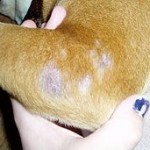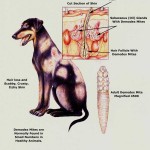Tails
Making pet parenting easy
Mange (demodicosis) in Dogs
This entry was posted on 2014-07-01.
Mange (demodicosis) is caused by a variety of Demodex mites which inhabit the hair follicles of dogs and lead to an inflammatory disease. The severity of the symptoms will depend on the type of mite that is infecting the dog. It can lead to skin lesions, genetic disorders, problems with the immune system and hair loss (alopecia).
Symptoms and Types
The symptoms of mange include hair loss, a redness of the skin (erythema) with the appearance of scale and lesions.
It may either be localised to one particular part of the dog’s body or it may be widespread affecting the entire body. If the infestation is mild and localised, the lesions tend to occur on the face, trunk or legs.
Causes
The exact cause of mange is not known but many experts believe that the dog’s immune system has a role to play, in particular with regards to the severity and whether it is localised or generalised.
There are three species of mites that have been implicated in mange in dogs but little is known about the mode of transmission. There is however one type of mite, Demodex canis that inhabits the hair follicles and may transfer from mother to newborn during nursing.
Treatment
The treatment depends upon the severity of the mange. Localized disease often resolves spontaneously in about 90% of cases. In the more extreme cases, medication may be required to control the condition and relieve the symptoms.
An evaluation by an expert is important in the management of mange and may involve skin scrapings and urine samples to assist with the diagnosis and guide the treatment plan.
Prevention
General good health may help prevent some cases of mange and it is recommended that dogs who suffer from generalised chronic mange are not bred as they are likely to pass the condition to their offspring.
Living and Management
In cases of generalised chronic mange, long term medication may be necessary. Regular skin scrapings may be done to continually monitor the presence of mites and to assess the progress of treatment.




